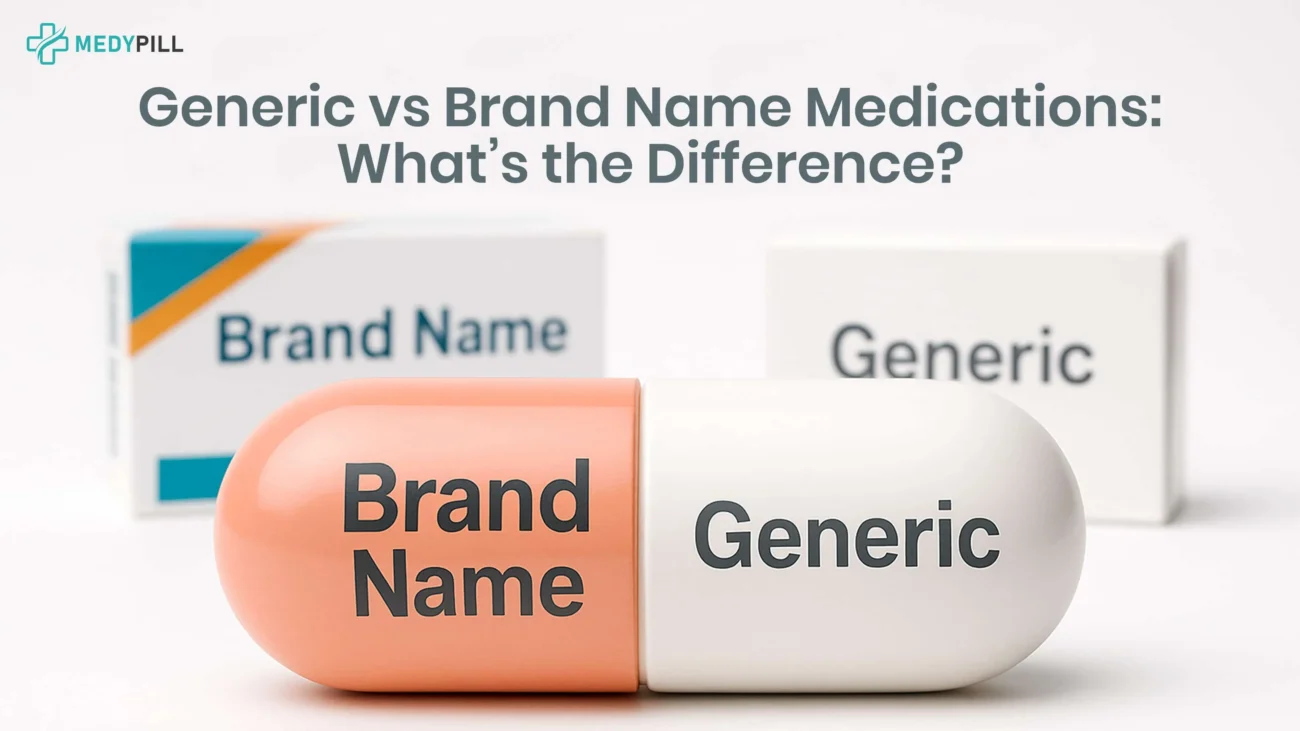
What is the Difference Between Sildenafil and Tadalafil?
Sildenafil vs Tadalafil: Quick Overview

Struggling with erectile dysfunction (ED) can impact not only your physical intimacy but also your confidence and quality of life.
With so many treatment options, choosing the right one can feel overwhelming.
You might be wondering:
- Which medication will work best for me?
- Will it last long enough?
- What if it doesn’t work when I need it to?
These are common questions that can make the decision stressful.
This guide breaks down the core differences between the two most prescribed ED medications, sildenafil and tadalafil.
Backed by science and written in simple terms, you’ll get the clarity you need to make an informed, confident choice alongside your healthcare provider.
What is Sildenafil? (The Blue Pill Explained)

Sildenafil is one of the most well-known medications for treating ED and is commonly recognized by its brand name, Viagra.
It was the first oral ED treatment approved by the FDA in 1998, revolutionizing how erectile dysfunction was managed.
Mechanism: Sildenafil works by inhibiting the PDE5 enzyme, which breaks down a substance called cyclic GMP (cGMP) in the penis. cGMP relaxes smooth muscle cells, allowing for increased blood flow during sexual stimulation.
Effectiveness: Sildenafil shows a strong success rate, ranging from 43% in post-prostatectomy patients to up to 85% in men with neurological conditions, averaging around 82%.
Usage: Sildenafil is designed to be taken 30 minutes to 1 hour before sexual activity. It should be taken on an empty stomach for optimal results since high-fat meals can reduce its effectiveness.
Nickname: Sildenafil is often called the “little blue pill” due to its distinctive color and shape.
Popularity: Over 20 million men worldwide have used sildenafil, making it a trusted and well-documented treatment.
What is Tadalafil? (The Weekend Pill)

Tadalafil, sold under the brand name Cialis, was approved by the FDA in 2003 and quickly earned the nickname “the weekend pill” due to its long-lasting effects.
Mechanism: Like sildenafil, tadalafil also inhibits the PDE5 enzyme, but it has a longer half-life of 17.5 hours, allowing for prolonged effectiveness.
Duration: Tadalafil effects can last up to 36 hours and occasionally as long as 48 hours, depending on the individual.
Usage: Tadalafil can be taken either as needed or daily. The on-demand dose ranges from 10 to 20 mg, while the daily dose is typically 2.5 to 5 mg.
Flexibility: Its dual dosing option makes it suitable for both planned and spontaneous sexual activity.
Patient Preference: Studies show 69% to 71% of users prefer tadalafil, mainly due to its long duration and lower pressure to time intercourse.
Sildenafil vs Tadalafil: Key Differences

Here’s a quick look at how sildenafil and tadalafil differ in key areas like duration, onset, food effects, and usage style.
Duration of Action
- Sildenafil: Effective for about 4 to 6 hours, with some users reporting effects up to 12 hours.
- Tadalafil: Known for lasting up to 36–48 hours, giving it the nickname “weekend pill.”
Onset Time
- Sildenafil: Begins working in about 30–60 minutes, sometimes as soon as 12 minutes.
- Tadalafil: Takes approximately 30 minutes to 2 hours to become effective, although some users experience effects in 15–16 minutes.
Food Interactions
- Sildenafil: High-fat meals can delay absorption and reduce the effectiveness of sildenafil.
- Tadalafil: Not significantly affected by food; can be taken with or without meals.
Daily vs On-Demand Use
- Sildenafil: Only available for on-demand use before planned sexual activity.
- Tadalafil: Offers both on-demand and daily dosing for ongoing readiness.
Side Effects Comparison: Sildenafil vs Tadalafil
Both drugs are generally well-tolerated but have different side effect profiles:
| Side Effect | Sildenafil | Tadalafil |
| Headache | 25.4% | Common |
| Flushing | 30.8% | Less frequent |
| Nasal Congestion | 18.7% | Rare |
| Blue Vision | ~3% | Rare |
| Back/Muscle Pain | Rare | More common |
| Indigestion | Common | Common |
Serious Risks (Rare but Possible):
- Priapism: Erection lasting more than 4 hours, which requires urgent medical attention.
- Sudden Vision or Hearing Loss: Uncommon, but serious, and requires immediate consultation.
Tadalafil is associated with slightly more back and muscle pain, while sildenafil users more often report visual disturbances.
Dosage Guidelines for Both Medications

Here’s a brief overview of how to use sildenafil and tadalafil effectively for optimal results and safety.
Sildenafil
- Starting Dose: 50mg as needed
- Range: 25mg to 100mg
- Max Frequency: Once per day
- Best Taken: 30 minutes to 1 hour before sex, ideally on an empty stomach
Tadalafil
- On-demand Use: Start at 10mg; range is 5–20mg
- Daily Use: 2.5mg to 5mg once per day
- Max Frequency: Once daily
- Flexibility: Can be taken with or without food; allows for more spontaneity
Always follow your doctor’s dosage instructions, especially if you have health conditions such as liver or kidney issues, or if you’re taking other medications.
Source: Dosage Parameters for Sildenafil, Vardenafil, and Tadalafil
Sildenafil or Tadalafil: Which One is Right for You?
Which ED medication fits your needs? Here’s a quick guide to help you decide, based on your lifestyle and preferences.
Choose Sildenafil if:
- You want a short-acting medication
- You have infrequent sexual activity
- You want a lower-cost option (generics are widely available)
- You prefer to plan sexual activity around medication timing
Choose Tadalafil if:
- You want a longer-lasting option
- You want the flexibility of spontaneous sexual activity
- You prefer daily low-dose therapy
- You don’t want to worry about food intake or timing
Ultimately, your healthcare provider can help you weigh these considerations based on your lifestyle, health status, and sexual activity patterns.
Doctor’s Consultation and Legal Considerations
Both sildenafil and tadalafil are prescription-only medications, and their use should be closely supervised by a qualified healthcare provider.
Key Medical Considerations:
- Cardiovascular health assessment is essential
- Avoid use with nitrate medications (e.g., for chest pain) due to the risk of dangerous blood pressure drops
- Discuss all current medications to avoid interactions
- Adjust doses if you have liver or kidney problems
- Not suitable for men with certain eye disorders or severe hypotension
Never self-prescribe or purchase ED medications from unverified sources. Always go through licensed providers.
Final Thoughts: Sildenafil vs Tadalafil
Both sildenafil and tadalafil are effective, well-studied, and safe treatments for erectile dysfunction when used correctly.
However, they offer different benefits based on timing, flexibility, side effects, and patient preference.
- Sildenafil is ideal for men seeking a reliable, short-term solution, with decades of research supporting its use.
- Tadalafil suits those looking for extended effectiveness and greater spontaneity, or those who prefer a low-dose daily option.
Choosing the proper medication is a personal decision that should involve your doctor. Together, you can select the option that best aligns with your health status, sexual activity, and lifestyle.
FAQs
1. Can I switch between sildenafil and tadalafil?
Answer: Yes, but only under medical supervision. Leave at least 24 hours between switching.
2. Which medication works faster?
Answer: Sildenafil may have a slightly quicker onset in some users.
3. Are these drugs safe for older men?
Answer: Yes, but starting at lower doses is typically recommended.
4. Can I drink alcohol while taking these drugs?
Answer: Light drinking is okay, but excess alcohol may reduce effectiveness and increase side effects.
5. What if the medication doesn’t work?
Answer: Try it a few times (4–8) before judging. Dosage adjustments might help.
6. Are generics as effective as brand names?
Answer: Yes. Generic drugs contain the same active ingredients.
7. Can I cut the tablets?
Answer: Only if the pill is scored. Ask your pharmacist first.
8. Is it safe to use these medications long term?
Answer: Yes, if monitored by your healthcare provider.
9. Do these drugs affect fertility?
Answer: No evidence suggests a negative impact on fertility.
10. Which is more affordable?
Answer: Generic sildenafil is usually less expensive than tadalafil.

Aug 12, 2025
Generic and brand name medications work the same. They treat the same conditions and use the same main ingredients. The big difference is price generics…
VIEW DETAILSAug 12, 2025
Fenbendazole is not considered safe for human use according to the FDA and major medical bodies. While some people are…
Aug 12, 2025
Semaglutide helps people lose weight by lowering hunger and making them feel full for longer. It’s available as a weekly…

